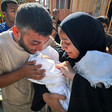The Electronic Intifada 16 January 2004
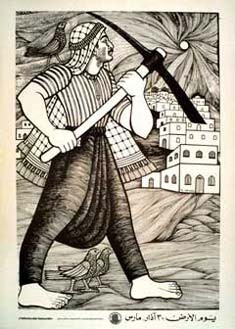
“Land Day” Abdel Rahman Al Muzain, 1984
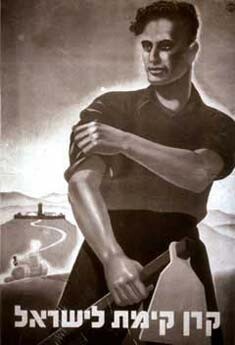
Jewish National Fund poster, 1950
Most Americans find the idea of the political poster to be alien, and dismiss the concept as mere propaganda, a term that automatically takes a negative connotation in the U.S. vernacular. We look at revolutionary Cuba and reject murals and posters of Ché Guevara and Fidel Castro as being anti-democratic propaganda. But we Americans have our own propaganda, found in the advertising that colonizes every space imaginable, from the posters that overwhelm us as we wait for the bus, to giant billboards that loom over our highways, and the logos on the very clothes we wear.
What both political posters and advertisement have in common, if indeed one considers them separate, is the use of graphic design to sell or promote a concept or message. In the U.S.’ current jingoistic culture, we have SUV manufacturers urging consumers to exhibit their patriotism by purchasing a gas-guzzling vehicle. In Cuba, Ché Guevara’s two-dimensional bust, found on posters and painted on the sides of buildings, seems downright heroic, as his gaze turns upward and his beret acts as a sort of halo.
Dan Walsh, creator of the online exhibition Antonym/Synonym: The Poster Art of the Israeli-Palestinian Conflict, thinks that taking a look at political posters can enable “a new democratic discussion.” His website, Liberation Graphics, which features over 100 posters, a mere fraction of his collection, can only be described as a labor of love. Each poster is catalogued with an essay that both analyzes the poster’s formal and conceptual qualities, and places the subject matter within a brief historical context. And a sidebar provides viewers, and Walsh writes with an American audience in mind, with intelligent, thought provoking questions.
These “questions for a new democratic discussion” are beautifully ironic in the section of posters titled “Israeli Progressives.” Because for Israel, what is really at stake is its bragging right of being a democratic country, while it colonizes the West Bank, Gaza Strip, East Jerusalem, and Golan Heights and treats its own Arab citizens as a fifth column.
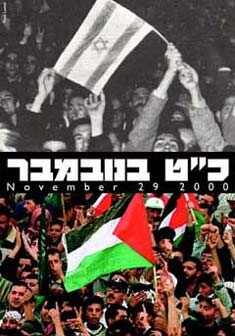
“November 29, 2000” Yossi Lemel, 2000
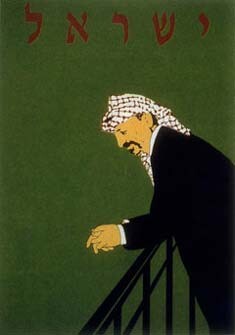
“Israel/40th Anniversary” Iris Dishon, 1988
The “Israeli Progressives” gallery is the most striking for an American viewer. One would expect from the “Palestinian Artists” and “Arab Solidarity” galleries the themes of catastrophe and displacement, and struggle towards freedom. But to viewers in a country where criticism of Israeli policy is all too often branded as anti-Semitic, in an increasingly shrill and knee-jerk fashion, the Israeli posters remind us how muddled the message of the opposition is in our own country.
There is a common theme of paralleling the Zionist movement and the Palestinian independence movement among the Israeli posters. Take Yossi Lemel’s “November 29, 2000.” The top half of the poster features a grainy black and white image of a crowd, with two men in the foreground holding up an Israeli flag. The photograph was taken November 29, 1947, the date the U.N. legitimized the Zionist’s caused by voting to separate Palestine into two separate Arab and Jewish states. But at the bottom of the poster is a photograph of a contemporary Palestinian rally, complete with the Palestinian flag, victory signs and fists in the air, echoing the image above taken over 50 years before.
Similar is Iris Dishon’s “Israel/40th Anniversary,” which portrays, in a minimalist fashion similar to Japanese woodcut prints, Yasser Arafat leaning over a balcony, with the Hebrew script at the top reading “Israel.” Of this visually and conceptually provocative poster, Walsh writes in the accompanying essay:
“Done entirely in the national colors of the Palestinian liberation movement — green, red, black, and white — Dishon seeks to drive home the point that just as Herzl founded the Zionist Organization to pull together the disparate elements of world Jewry to launch the rebirth of the Jewish nation, so Yasser Arafat set out to pull together the often fractious elements of Palestinian society when he took control of the Palestine Liberation Organization (PLO) in 1968. By morphing Herzl into Arafat Dishon eliminates all moral distinctions between the origins and objectives of their respective movements.”
Walsh also points out to viewers the similarity between Palestinian posters and Zionist posters that emphasize land and labor. Abdel Rahman Al Muzain’s “Land Day,” circa 1984, illustrates a keffiya-donned peasant in traditional clothing carrying a pickaxe, flanked by three birds that likely represent freedom and peace. It is quite similar to a Jewish National Fund poster from the 1950s of a young man who rolls up his sleeve while holding hoe with a tractor in the background.
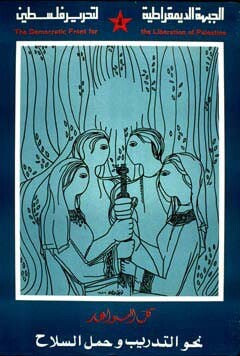
“All Arms” Tawfiq Abdel Al, 1976
But there are interesting posters that call for an armed struggle, like “All Arms,” by Tawfiq Abdel Al, published by The Democratic Front for the Liberation of Palestine, circa 1976. The poster, which is surprising because it doesn’t boast the green, black, red, and white Palestinian national colors like one would expect, features two men and women, beautifully drawn in a fluid contour line fashion that was popular in the ’70s, holding a rifle. The figures, wearing traditional clothing, are encircled by abstracted olive trees while the sun hovers directly above.
Antonym/Synonym also features posters that promote literacy and education among Palestinian youth and that advocate a more visible public role for women. Adnan Zubeidey’s “Enough Silence!”, from 2001, depicts the echoed profile of a woman’s face, who is at first gagged and blue, but in the third profile speaks freely and with conviction. The Arabic script reads, “Enough silence … The repression has become intolerable. No to violence from now on.”
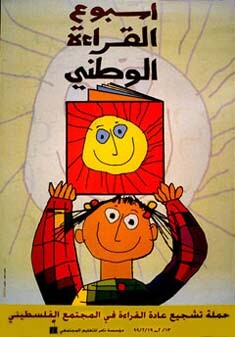
National Literacy Week poster, 1999
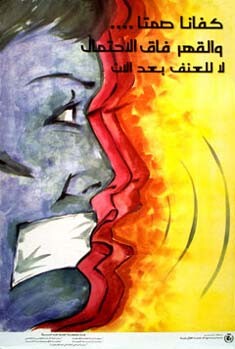
“Enough Silence!” Adnan Zubeidey, 2001
This poster reminds viewers of the double occupation that women experience in Palestine. Not only do they have to endure the innumerable hardships commonly shared by both men and women under Israeli military rule, but they also must struggle against the social restrictions of antiquated, repressive attitudes towards women that seem to be compounded when men are humiliated by the occupation and all too often take out their frustrations on their wives at home. As a Palestinian woman explains in an interview in the book Stateless in Gaza, “I don’t think Palestine will be liberated without the women being liberated first. I mean how can our society be called progressive enough to defeat Zionism if half of that society is enslaved inside the home?”
The role of women in the effort towards freedom is just one of the many questions that arise from this online exhibition. The posters also present the conflict in a way that no newspaper report or detailed history book can accomplish. They emphasize the human element of the conflict, the metaphysical as well as the practical aims and concerns of the people it most severely affects: the Palestinians.
Maureen Clare Murphy is an Arts, Music, and Culture correspondent for EI and its sister site eIraq.
